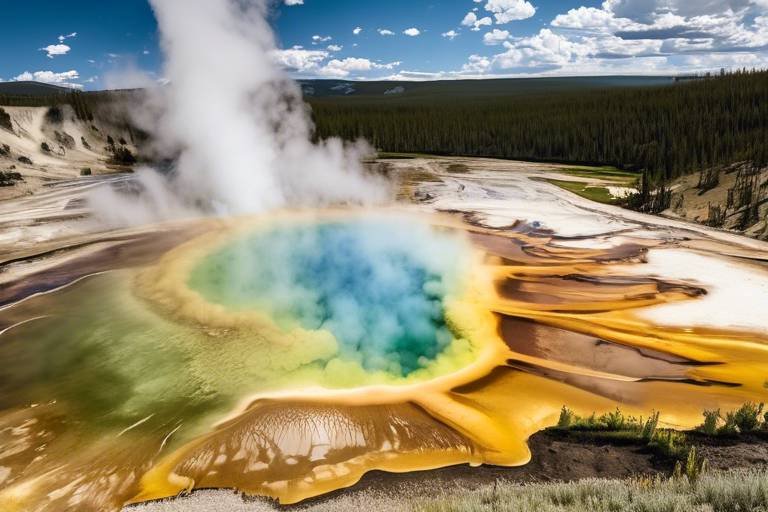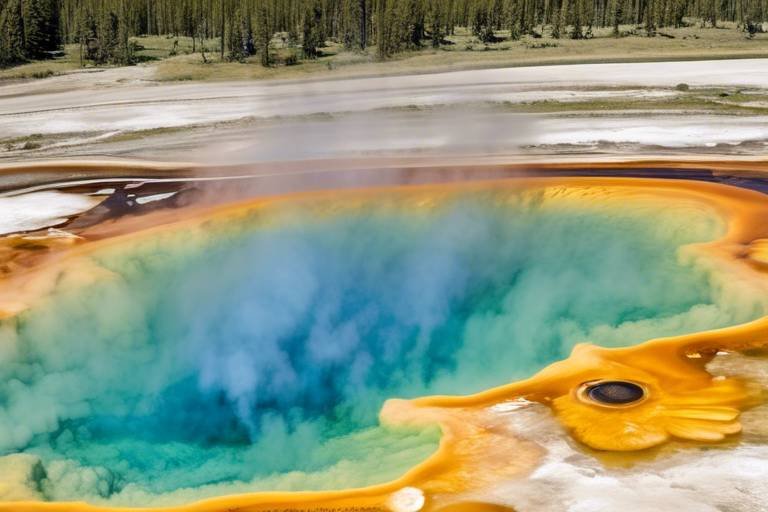Eco-Conscious Tips for Visiting the United States’ Yellowstone National Park
When planning your visit to the iconic Yellowstone National Park in the United States, it's essential to embrace eco-conscious practices that not only enhance your experience but also contribute to the preservation of this natural wonder. By following these tips, you can explore the park responsibly while immersing yourself in its breathtaking beauty.

Plan Ahead for Sustainable Transportation
When planning your visit to Yellowstone National Park, it's essential to consider sustainable transportation options to minimize your environmental impact. By choosing eco-friendly ways to get around, you can reduce emissions and congestion, contributing to the preservation of the park's natural beauty.
Public buses and shuttles are convenient and eco-conscious choices for exploring the park without adding to traffic congestion. These transportation options not only reduce your carbon footprint but also help in preserving the park's air quality by decreasing the number of individual vehicles on the roads.
Another sustainable transportation method to consider is carpooling with other visitors or joining organized group tours. Sharing rides not only reduces emissions but also fosters a sense of community among travelers, creating a more enjoyable and environmentally friendly experience at Yellowstone National Park.
By planning ahead and opting for sustainable transportation methods, you can play a significant role in protecting the ecosystem of Yellowstone National Park while enjoying all it has to offer. Whether you're exploring the geysers, hiking the trails, or admiring the wildlife, your conscious choices in transportation can make a difference in preserving this natural wonder for future generations.

Leave No Trace: Pack It In, Pack It Out
When visiting Yellowstone National Park, it is crucial to adhere to the principle of Leave No Trace to minimize your impact on the environment. This means packing out all waste and trash that you bring into the park. By following this practice, you can help preserve the pristine beauty of Yellowstone for future generations to enjoy.
Imagine a scenario where every visitor left behind their garbage and waste – the park would quickly lose its natural charm and become littered with debris. By packing in and packing out, you are not only showing respect for the environment but also setting an example for others to follow.
One way to ensure you leave no trace is to carry a small trash bag with you during your visit. This way, you can collect any wrappers, bottles, or other waste items and dispose of them properly when you leave the park. Additionally, consider using reusable containers and utensils to minimize single-use plastic waste.
Moreover, educating yourself and fellow travelers about the importance of Leave No Trace can have a ripple effect. By spreading awareness about responsible waste management, you can help create a culture of environmental stewardship among park visitors.
Remember, the goal of Leave No Trace is to leave the natural environment as undisturbed as possible. By taking the extra step to pack out your trash, you are contributing to the conservation of Yellowstone's ecosystems and ensuring that the park remains a haven for both wildlife and visitors alike.

Respect Wildlife from a Distance
When visiting Yellowstone National Park, it's essential to to ensure the safety of both the animals and yourself. While it may be tempting to get closer for a better view or a perfect photo, it's crucial to remember that these are wild animals in their natural habitat. Approaching them can disrupt their behavior, cause stress, and even lead to dangerous encounters.
Imagine you're in their home, and they are the hosts. Just as you wouldn't want uninvited guests invading your personal space, the wildlife at Yellowstone deserves the same respect. By observing from a safe distance, you can admire their beauty and behavior without causing harm or disturbance.
One way to ensure you're keeping a safe distance is to use binoculars or a camera with a zoom lens to get a closer look without physically approaching the animals. This way, you can capture stunning images while maintaining a respectful distance that won't disrupt their natural activities.
Remember, these animals are not here for our entertainment but play vital roles in the ecosystem. By keeping your distance, you're not only protecting them but also contributing to the overall balance and harmony of Yellowstone's diverse wildlife population.

Choose Sustainable Accommodation
When visiting Yellowstone National Park, choosing sustainable accommodation is a crucial step towards minimizing your environmental impact. By opting for eco-friendly lodging options, you can contribute to the conservation efforts within or near the park while enjoying a greener stay.
Many accommodations in and around Yellowstone National Park have embraced sustainability practices to reduce their carbon footprint and preserve the natural surroundings. These establishments often implement energy-efficient measures, waste reduction strategies, and eco-friendly amenities to provide guests with a comfortable yet environmentally conscious experience.
Staying at sustainable accommodations not only supports conservation initiatives but also allows you to immerse yourself in the park's ecosystem without compromising its delicate balance. From cozy lodges to eco-luxury resorts, there are various options available that prioritize environmental stewardship and offer a unique experience in harmony with nature.
Additionally, sustainable accommodations often source local and organic products, promote wildlife protection, and engage in community initiatives that benefit the environment and local communities. By choosing to stay at these eco-conscious establishments, you can actively participate in sustainable tourism practices and contribute to the preservation of Yellowstone National Park's natural beauty for future generations.

Conserve Water and Energy
When visiting Yellowstone National Park, it's essential to be mindful of your water and energy consumption to minimize your environmental impact. By adopting simple yet effective practices, you can contribute to the park's sustainability efforts while enjoying its natural beauty.
One of the easiest ways to conserve water during your stay is by taking shorter showers and turning off the faucet while brushing your teeth. Additionally, consider reusing towels to reduce laundry and water usage in your accommodation.
For energy conservation, make it a habit to turn off lights, air conditioning, and heating when not in use. Adjusting the thermostat by a few degrees can also make a significant difference in reducing energy consumption throughout your visit.
Another eco-friendly tip is to opt for reusable water bottles and refill stations instead of purchasing single-use plastic bottles. By staying hydrated with a reusable bottle, you not only reduce plastic waste but also minimize the energy required for bottle production and disposal.
When dining at restaurants within or near the park, choose establishments that prioritize energy-efficient practices and sustainable sourcing of ingredients. Supporting businesses that value environmental conservation can have a positive impact on the overall sustainability of Yellowstone National Park.
Remember, small actions can add up to significant savings in water and energy consumption, benefiting both the park and future generations of visitors. By being mindful of your resource usage, you can play a part in preserving the natural wonders of Yellowstone National Park for years to come.

Support Local and Sustainable Businesses
When visiting Yellowstone National Park, one of the ways you can contribute to its conservation efforts is by supporting local and sustainable businesses. By choosing to dine at restaurants and purchase souvenirs from establishments that prioritize sustainability, you not only support the local economy but also help reduce the park's overall environmental impact.
Local businesses often source their products locally, reducing transportation emissions and supporting nearby communities. This direct connection to the region ensures that your purchases have a positive impact on the environment and the livelihoods of local residents. Additionally, sustainable businesses typically implement eco-friendly practices such as using renewable energy sources, reducing waste, and supporting conservation initiatives.
By supporting these establishments, you are aligning your values with your actions, promoting a more sustainable tourism industry in and around Yellowstone National Park. Whether you choose to enjoy a meal at a farm-to-table restaurant, purchase handmade gifts from a local artisan, or stay at an eco-conscious lodge, your choices can make a difference in preserving the natural beauty of the park for future generations.

Follow Park Regulations and Guidelines
When exploring Yellowstone National Park, it is crucial to adhere to the park's regulations and guidelines to ensure the preservation of its natural beauty and wildlife. By following these rules, visitors can contribute to the conservation efforts and maintain the park's ecological balance.
One of the essential guidelines to follow is staying on designated trails to prevent damage to fragile ecosystems and habitats. Venturing off-trail can disrupt vegetation and wildlife, impacting the park's delicate environment. Additionally, respecting wildlife by observing them from a safe distance is vital for their well-being and your safety.
Proper waste disposal is another key aspect of park regulations. Visitors must pack out all trash and dispose of it in designated bins to prevent littering and protect wildlife from consuming harmful materials. By adhering to the "Pack It In, Pack It Out" principle, visitors can minimize their environmental impact.
Driving regulations within the park also play a significant role in preserving its natural resources. Speed limits and parking restrictions are in place to safeguard wildlife and prevent habitat destruction. Utilizing eco-friendly transportation options such as shuttles and carpooling can help reduce congestion and emissions, promoting a more sustainable visit.
Furthermore, understanding and abiding by fishing and camping regulations are essential for maintaining the park's ecological balance. Fishing permits and campsite reservations help manage visitor impact and ensure the sustainability of these recreational activities within the park.
By familiarizing yourself with and adhering to Yellowstone National Park's regulations and guidelines, you can contribute to the conservation of this iconic natural treasure and help protect it for future generations to enjoy.

Join Conservation Programs and Volunteer Opportunities
When visiting Yellowstone National Park, you have the incredible opportunity to engage in conservation programs and volunteer opportunities that contribute to the preservation of this natural wonder. By joining these initiatives, you not only give back to the environment but also gain a deeper understanding of the park's ecosystem and the efforts required to protect it.
One way to get involved is by participating in conservation programs organized by the park or partnering with local organizations dedicated to environmental stewardship. These programs often involve activities such as habitat restoration, wildlife monitoring, and educational outreach to raise awareness about conservation issues.
Volunteer opportunities at Yellowstone National Park range from short-term projects to longer-term commitments, allowing visitors to contribute based on their availability and interests. Whether you're passionate about wildlife conservation, sustainable practices, or environmental education, there is a volunteer role suited to your skills and dedication.
By actively participating in conservation programs and volunteer opportunities, you become a steward of Yellowstone's natural resources, helping to protect its unique landscapes and diverse wildlife for future generations to enjoy. Your involvement not only makes a tangible difference in the park's conservation efforts but also fosters a sense of connection and responsibility towards the environment.
Frequently Asked Questions
- What are the best eco-conscious practices to follow when visiting Yellowstone National Park?
When visiting Yellowstone National Park, it is essential to practice sustainable transportation, leave no trace by properly disposing of waste, respect wildlife from a safe distance, choose eco-friendly accommodation, conserve water and energy, support local businesses, follow park regulations, and engage in conservation programs.
- How can I reduce my environmental impact while exploring Yellowstone National Park?
To reduce your environmental impact at Yellowstone, consider using eco-friendly transportation options, minimizing waste by packing out all trash, being mindful of wildlife habitats, opting for sustainable lodging, conserving water and energy, supporting local and sustainable businesses, adhering to park rules, and participating in volunteer conservation programs.
- Why is it important to support conservation efforts at Yellowstone National Park?
Supporting conservation efforts at Yellowstone is crucial to preserve the park's natural beauty, protect wildlife habitats, maintain ecological balance, and ensure future generations can continue to enjoy the park's wonders. By engaging in conservation programs, visitors can actively contribute to the sustainability of Yellowstone National Park.



















